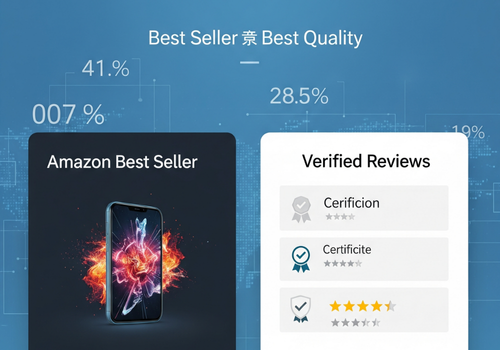Are Amazon’s Best Sellers Really the Best? The Hidden Truth About Rankings and Manipulated Reviews
What the “Best Seller” Badge Really Means
Amazon’s Best Seller badge is algorithmically assigned to products that rank highest in terms of sales within a specific category or subcategory. This means that a product can earn the badge not because it’s the best in terms of quality or value, but simply because it has sold more units than its competitors — sometimes in a very narrow timeframe. Sellers who master the art of timing, pricing, and ad spend can trigger a sales surge that results in this badge, even if the product itself is poorly made, not certified, or backed by fake reviews. The badge reflects momentum, not necessarily long-term customer satisfaction.
The Dark Reality: How Sellers Manipulate Rankings and Trick the System
In 2025, black-hat tactics are still widely used to trick Amazon’s algorithms and climb to the top. These include review farms, coupon abuse, bot orders, and fake buyers incentivized through platforms like Telegram or shady Facebook groups. Sellers may pay people to buy their product, leave glowing 5-star reviews, and boost ranking artificially. Some even use “search-find-buy” schemes to simulate organic sales. The result? Products with fake trust signals dominate the listings. As a consumer, you’re not always seeing the best options — you’re seeing the most aggressively manipulated ones.
Fake Reviews Inflate Trust — Here’s How to Spot Them
Safety should be your top priority when selecting any supplement. Products that are truly safe often carry third-party certifications like NSF Certified, USP Verified, or Informed-Sport, which ensure that the supplements have been tested for quality, purity, and label accuracy. Authentic products will also have tamper-proof packaging, expiration dates, and batch or lot numbers. Reading the supplement label closely is key. It should clearly list all ingredients, dosages, directions for use, and allergen warnings. Additionally, it’s wise to ensure that the product is sold by the brand itself and fulfilled by Amazon, which often helps with proper storage and shipping conditions.
What to Look for Beyond the Badge
Instead of using the Best Seller label as your sole buying criteria, dive deeper into the product and brand. Start by reading the most recent and critical reviews, especially those with images and detailed feedback. Check whether the product description includes clear ingredient lists, third-party testing information, or certifications like USDA Organic, NSF, or USP. Look for signs of brand transparency — including contact information, return policies, and an official Amazon storefront that links to a professional website. High-quality brands often invest in educating the customer rather than relying solely on flashy labels or trending ranks.
The Role of Third-Party Testing and Certifications
True quality in supplements, skincare, or electronics is often revealed not in the popularity metrics but in third-party testing and certifications. Trusted certifications signal that a product has passed objective, unbiased tests for safety, potency, and manufacturing quality. These are not required for a product to become a Best Seller, but they’re essential for consumer trust. Many top-performing but unregulated products may skip this step entirely, which can lead to safety issues. By prioritizing products that offer verified test results, you can safeguard your health and finances even when shopping in high-volume categories.
Why Reviews Can Be Just as Manipulated
Another key factor contributing to the success of so-called “Best Sellers” is the presence of inflated, inauthentic, or manipulated reviews. Some sellers participate in review swap groups, offer incentives for positive feedback, or use bots to post fake reviews. These practices are against Amazon’s policies but still persist in many product categories. This creates a false sense of trust for shoppers who don’t dig deeper. Look for patterns in the reviews — repetitive language, vague praise, or sudden spikes in review volume — which often indicate manipulation. Use review-checker tools or browser extensions to assess the authenticity before making a purchase.
Conclusion: Be Smarter Than the Algorithm
The Best Seller badge may reflect popularity, but it doesn’t reflect quality. To truly protect your money and your well-being, you must look beyond Amazon’s visual rankings and take control of your own research. Analyze reviews critically, search for certifications, understand the ingredients, and verify the brand’s legitimacy. Don’t let hype drive your decisions — especially in product categories that impact your health, safety, or long-term use. As a shopper in 2025, staying informed and skeptical is your strongest advantage on a marketplace driven more by sales velocity than substance.

